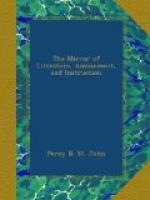Between the two heads which form the entrance into Swan River, there is, unfortunately, a bar, made by the continuity of the limestone ridge. Over this bar, the depth, at low water, is but six feet, and is therefore practicable only for boats or rafts. About a mile inside the heads, the water deepens; and then commences a succession of cliffs, or natural wharfs, with four, five, and six fathoms at their bases. The same depths are extended over a magnificent expanse of salt water, to which Captain Stirling has given the name of “Melville Water;” and which, in his opinion, wants only a good entrance to make it one of the finest harbours in the world, being seven or eight miles in length, by three or four in width, and having a depth of water from four to seven fathoms. This narrow entrance of the river, he thinks, might be made navigable by ships of burthen, without difficulty or great expense.
When the town begins to rise, and substantial buildings are required, the blocks of stone procured by quarrying this entrance will go far towards paying the expense of excavation.
Into this expansive sheet of water fall two rivers; one from the north-east, which is properly the Swan River; the other from the south-east, called Canning’s River. Captain Stirling examined them both: the former to its source, the latter beyond the point where the water ceased to be brackish. They are both sufficiently convenient for boat navigation, even at the end of the dry season; and any obstruction might easily be removed to make them more so, by which the productions of an immense extent of country might be transported by water-carriage.
Mr. Fraser remarks that nothing of the mangrove appears along the banks of the Swan River, the usual situation of this plant being here occupied by the genus Metrosideros. The first plain, or flat, as it is called, contiguous to the river, commencing at Point Fraser, is formed of a rich soil, and appears, by a deposit of wreck, to be occasionally flooded to a certain extent. Here are several extensive salt marshes, which Mr. Fraser thinks are admirably adapted for the growth of cotton. The hills, though scanty of soil, are covered with an immense variety of plants; among others, a magnificent species of Angophera occupied the usual place of the Eucalyptus, which, however, here as on the eastern side, generally forms the principal feature in the botany of the country, accompanied by Mimosa, Correa, Melaleuca, Casuarina, Banksia, and Xanthorea. The brome, or kangaroo glass, was most abundant. On a more elevated flat, a little further up the river, the botanist observes that the “magnificence of the Banksia and arborescent Zamia, which was here seen thirty feet in height, added to the immense size of the Xanthorea near this spot, impart to the forest a character truly tropical.” He says that about five miles to the eastward of the river, there is an evident change in the character of the country: extensive plains of the richest description, consisting of an alluvial deposit, equalling in fertility those of the banks of the River Hawkesbury in New South Wales, and covered with the most luxuriant brome grass. The Casuarina, so common near the limestone ridge of the coast, here disappears, and is succeeded by a pendulous species of Metrosideros, which continues to the source of the river.




